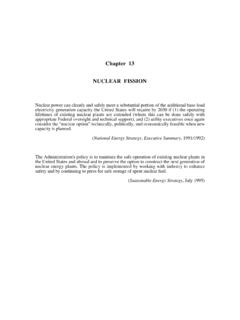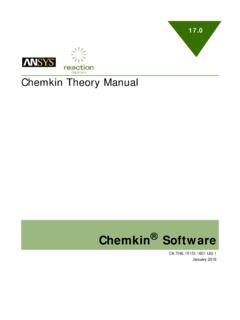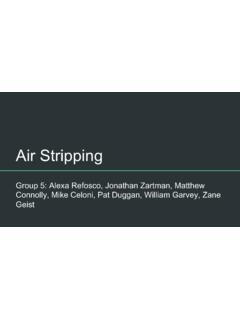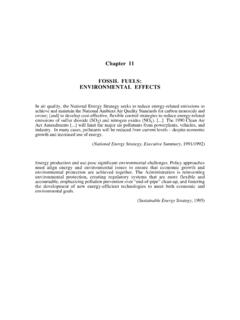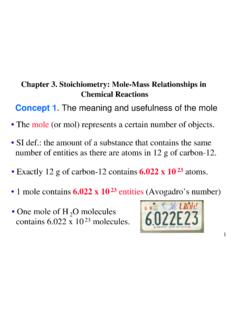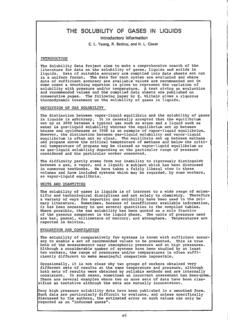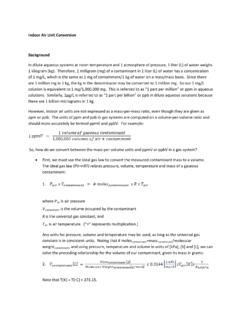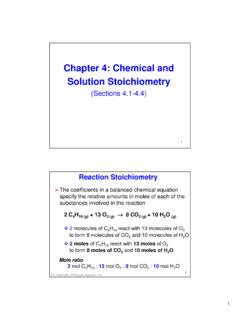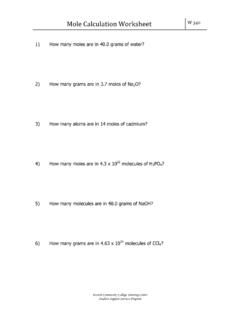Transcription of CHEMKIN Tutorials Manual - Pennsylvania State University
1 10112/15112 CHEMKIN Tutorials ManualCHEMKIN SoftwareCK-TUT-10112-1112-UG-1 December 2011 Licensing:For licensing information, please contact Reaction Design at (858) 550-1920 (USA) or Support:Reaction Design provides an allotment of technical support to its Licensees free of charge. To request technical support, please include your license number along with input or output files, and any error messages pertaining to your question or problem. Requests may be directed in the following manner: E-mail: Fax: (858) 550-1925, Phone: (858) 550-1920. Additional technical support hours may also be purchased. Please contact Reaction Design for the hourly :Copyright 2011 Reaction Design. All rights reserved. No part of this book may be reproduced in any form or by any means without express written permission from Reaction : CHEMKIN and REACTION DESIGN are registered trademarks of Reaction Design in the United States and other , CONP, CHEMKIN -CFD, CHEMKIN , CRESLAF, ENERGICO, EQUIL, EQUILIB, FORT , KINETICS, MODEL FUELS CONSORTIUM, OPPDIF, OVEND, PARAMETER STUDY FACILITY, PARTICLE TRACKING FEATURE, PASR, PLUG, PREMIX, REACTION WORKBENCH, SENKIN, SHOCK, SPIN, SURFACE CHEMKIN , SURFTHERM, TRANSPORT, TWAFER, TWOPNT are all trademarks of Reaction Design or Sandia National Laboratories.
2 All other trademarks are the property of their respective of Warranty:The software is provided as is by Reaction Design, without warranty of any kind including, without limitation, any warranty against infringement of third party property rights, fitness or merchantability, or fitness for a particular purpose, even if Reaction Design has been informed of such purpose. Furthermore, Reaction Design does not warrant, guarantee, or make any representations regarding the use or the results of the use, of the software or documentation in terms of correctness, accuracy, reliability or otherwise. No agent of Reaction Design is authorized to alter or exceed the warranty obligations of Reaction Design as set forth herein. Any liability of Reaction Design, its officers, agents or employees with respect to the software or the performance thereof under any warranty, contract, negligence, strict liability, vicarious liability or other theory will be limited exclusively to product replacement or, if replacement is inadequate as a remedy or in Reaction Design s opinion impractical, to a credit of amounts paid to Reaction Design for the license of the Citation for CHEMKIN and CHEMKIN -PRO: CHEMKIN 10112 should be cited as: CHEMKIN 10112, Reaction Design: San Diego, 15112 should be cited as: CHEMKIN -PRO 15112, Reaction Design: San Diego, 2011 Reaction DesignCHEMKINC ontents Table of in Gas-phase Processes.
3 Flame Temperature .. Equivalence Ratio .. : Propane in Air .. : Stoichiometric Products .. , Flames and Gas-phase for H2/Air .. Times for Propane Autoignition .. Emission from High-pressure Flames with Gas Radiation [ CHEMKIN -PRO Only].. Formation in Radiating Opposed-flow Diffusion Flame [ CHEMKIN -PRO Only].. Speed of Stoichiometric Methane/Air Premixed Flame with Reaction Path Analyzer [ CHEMKIN -PRO Only].. Study: Propane/Air Flame Speed as a Function of Equivalence Ratio and Unburned Gas Opposed-flow Flame .. Extinction Analysis [ CHEMKIN -PRO Only].. Flame Analysis [ CHEMKIN -PRO Only] .. Combustion Charge Compression Ignition (HCCI) Engine .. HCCI Engine Simulation [ CHEMKIN -PRO Only] .. a Shock-tube Experiment .. Air (Shock).. in Complex Turbine Flame Tear Streams to Estimate Initial Gas Composition in an HCCI Engine with Exhaust Gas Recirculation (EGR) [ CHEMKIN -PRO Only].. Stirred Reactor for Methane/Air .. Inlet on a Plug Flow Reactor .. Non-premixed CH4/Air Flame.
4 135 CHEMKINT able of Contents 2011 Reaction Tracking Feature [ CHEMKIN -PRO Only] .. Formation and Growth in a JSR/PFR Reactor [ CHEMKIN -PRO Only] .. Particles in Flame Simulators [ CHEMKIN -PRO Only].. Method for Particle-Size Distribution with Pre-mixed Laminar Burner-Stabilized Stagnation Flame [ CHEMKIN -PRO Only].. Particle-Size Distributions in a Burner-Stabilized Stagnation Flame .. Particle Aggregation in a Batch Reactor [ CHEMKIN -PRO Only] .. Analysis [ CHEMKIN -PRO Only].. Analysis of NOx Emissions [ CHEMKIN -PRO Only] .. and CH4, C2H4, C2H6, C3H6, and Combustion and Soot Formation and Growth .. Mechanism ..1783 Catalytic Combustors, Converters and Catalytic Combustor .. Exhaust Aftertreatment with a Transient Inlet Flow .. Studies .. Study Facility for Surface Chemistry Analysis .. Oxidation on Pt .. Three-way Vapor Analysis of Chlorosilane CVD .. Analysis of Steady- State Thermal CVD .. for a Cylindrical Channel Flow .. in a Rotating Disk Reactor.
5 CVD in Planar Channel Flow Reactor .. Layer Deposition (ALD).. Simulations of ALD Process .. Etching .. Chlorine Plasma .. Chlorine Plasma PFR with Power Profile .. Plasma Etching of Silicon Dioxide .. Nitride CVD from Silicon Tetrafluoride and Ammonia .. Deposition from Silane .. Deposition from Trichlorosilane .. Plasma .. Plasma with SiO2 Etch Products ..2515 Chemical Mechanism Analysis .. Information .. Mechanism for Diamond CVD ..256 Table of ContentsTutorials ManualCK-TUT-10112-1112-UG-15 2011 Reaction DesignIndex ..269 CHEMKINT able of Contents 2011 Reaction Design6CK-TUT-10112-1112-UG-1CK-TUT-1011 2-1112-UG-17 2011 Reaction DesignCHEMKINC ontents List of Tables1-1 Reactor Models Used in Sample 202-1 Reactant Mole Fractions Sum to 252-2 Relative moles Normalized So Mole Fractions Sum to 252-3N2 as Added 262-4N2 as Component of 262-5 Determining Stoichiometric 272-6 Initial Temperatures and Ignition Times .. 362-7 Inlet velocities for pressures studied by Thomsen et al.
6 452-8 Test Engine 982-9 Composition of Initial Gas 992-10 Engine parameters of the validation 1032-11 Natural gas composition used in the validation 1032-12 Zone configuration used by the multi-zone model analysis for the validation 1042-13 Components in Fuel and Oxidizer 1332-14 Properties of the Co-flowing of Data Representing Engine-out Test 193 CHEMKINList of Tables 2011 Reaction Design8CK-TUT-10112-1112-UG-1CK-TUT-1011 2-1112-UG-19 2011 Reaction DesignCHEMKINC ontents List of Figures2-1 Adiabatic Flame Temperatures Hydrogen/Air 242-2 Steady- State Gas-phase Combustion Hydrogen/Air Temperatures .. 292-3 Steady- State Gas-phase Combustion Molar Conversions .. 302-4 Autoignition for Hydrogen/Air Temperature 322-5 Autoignition for Hydrogen/Air Species Composition 322-6 Autoignition for Hydrogen/Air Sensitivity Coefficients .. 332-7 Temperature and OH Mole Fraction Profiles as a Function of 362-8 Ignition Based on Varying 372-9 Ignition Times vs. Inverse of Temperature (Semi-log).
7 372-10 Burner-stabilized Flame Experimental Gas Temperature 402-11 Burner-stabilized Flame Mole 412-12 Axial gas temperature profiles predicted with and without gas radiation heat loss as compared against experimental temperature profile for the phii= CH4/O2/N2 flame at 462-13 Comparisons of measured and predicted NO mole fraction profiles as a function of axial distance from the burner surface for the phi= CH4/O2/N2 flame at 462-14 Measured and predicted NO concentrations behind the phi= CH4/O2/N2 flame versus 472-15 Predicted axial velocity profile of Flame 1 studied by Atreya et al. 13 (p. 48). The location of (velocity) stagnation plane is indicated by the blue dash-dotted 512-16 Predicted gas temperature profile is compared against the experimental profile for Flame 1 studied by Atreya et al. 13 (p. 48).. 522-17 Comparisons of predicted and measured fuel (CH4) and oxidizer (O2) profiles for Flame 1 studied by Atreya et al. 13 (p. 48).. 522-18 Comparisons of predicted and measured profiles of H2 and CO for Flame 1 studied by Atreya et CHEMKINList of Figures 2011 Reaction Design10CK-TUT-10112-1112-UG-1al.
8 13 (p. 48).. 532-19 Predicted and measured C2H2 and OH profiles of Flame 1 studied by Atreya et al. 13 (p. 48). The OH peak indicates the flame front and the C2H2 peak marks the major soot growth 532-20 Predicted pyrene (A4) profile showing soot inception mainly occurs in the region between the stagnation plane and the diffusion flame in Flame 1 studied by Atreya et al. 13 (p. 48).. 542-21 Predicted soot volume fraction profile is compared against the experimental profile as a function of distance from the fuel nozzle for Flame 1 studied by Atreya et al. 13 (p. 48).. 542-22 Flame Speed Temperature Profile Panel .. 562-23C1_ Flame Speed Reactor Physical Properties .. 562-24 Flame Speed Axial Velocity vs. 582-25 Flame Speed Temperature vs. 592-26 Flame Speed Output Calculation pane with Sensitivity 602-27 Flame Speed Analyze Results panel with Reaction Path Analyzer 612-28 Flame Speed Altering the solution chosen, and y variable shown in the solution 622-29 Flame Speed Switching to a hierarchical layout 632-30 Flame Speed Increased complexity in the diagram due to changing the solution point, and increasing the number of allowed 642-31 Flame Speed Altering the zoom setting to see the contents of the 652-32 Flame Speed Decomposition pathways starting with 662-33 Flame Speed The Rate of Production and Sensitivity charts of 672-34 Flame Speed Splitting a composite reaction pathway into one per 682-35 Flame Speed Tree layout method of the decomposition of 692-36 Flame Speed Setting the hydroxide radical and oxygen radical as side species.
9 The source was switched from methane to oxygen, and the element filter was changed to O 702-37 Flame Speed Colored reactions based on influence of side 712-38 Panel for Setup of Parameter 732-39 Automatic Estimation of Starting Temperature Profile .. 742-40 Auto-Populate Option .. 762-41 Varying Each Parameter Independently .. 772-42 Parameter Study After Setup Is Complete .. 77 List of FiguresTutorials ManualCK-TUT-10112-1112-UG-111 2011 Reaction Design2-43 Post-Processor Options After Running Parameter 792-44 Cluster Endpoint vs. Parameter .. 802-45 Flame-Speed Calculated Values as a Function of Equivalence Ratio .. 812-46 Hydrogen/Air Flame Temperature vs. Axial 832-47 Hydrogen/Air Flame Mole 832-48 Hydrogen/Air Flame Temperature Sensitivity to Reaction 842-49 Hydrogen/Air Flame Temperature Sensitivity to Heats of Formation .. 842-50 Icon for Extinction of Premixed or Opposed Flow Flame 852-51 Extinction Basic reactor 872-52 Dynamic plotting of Temperature vs.
10 Extinction response, showing a turn at ~550 s-1 .. 892-53 Output file 902-54 Output file ExtinctionProfilesOut.. 912-55 Flame response curve showing extinction (turning) for premixed stoichiometric methane-air flame. The inlet temperature is 296 K and ambient pressure is 1 atm. The calculated extinction strain rate is 550 /s.. 922-56 Axial velocity and temperature profile for premixed stoichiometric methane-air flame at extinction point. The global strain rate at extinction is 289 s-1 .. 932-57 Axial velocity and velocity gradient magnitude for premixed stoichiometric methane-air flame at extinction point. Also shown are the points corresponding to the definitions of various extinction strain 932-58 Icon for Premixed Laminar Burner-Stabilized Stagnation Flame model.. 942-59 Parameter Study 952-60 Temperature and velocity profiles for two inlet 962-61 Major species mole faction profiles for each of two simulation runs.. 972-62IC Engine 982-63C1_ IC Engine Reactor Physical Property for HCCI Woschni Heat Loss 1002-64 HCCI Engine EGR Temperature 1012-65 HCCI Engine EGR Pressure Comparison.


